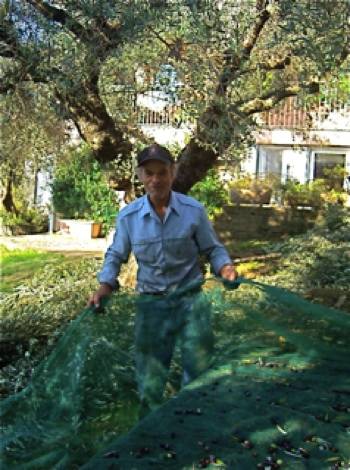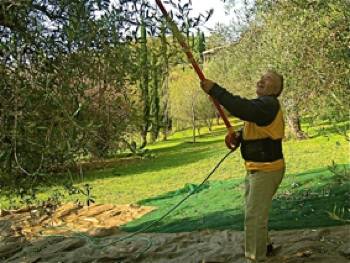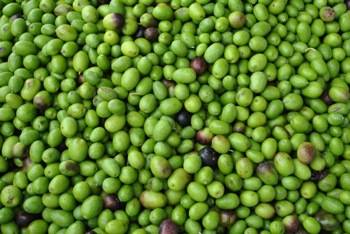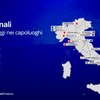Harvest Time for Olives
The Bible is filled with quotes about olive trees, but perhaps the loveliest is this: “His branches shall spread, and his beauty shall be as the olive tree, and his smell as Lebanon.” Who, reading these words in my little church in Bay Village, Ohio, would ever have guessed that I – never having seen an olive tree – would find myself with fifty olive trees, whose fruits we gather for olive oil that lasts us a year?
Iinitially we had just twenty-five gnarled elderly olive trees on our acre of land 30 miles north of Rome, but there was ample space for more. Moreover, our south-facing acre of orchard overlooks beautiful Lake Bracciano. With the sunshine and the mineral-rich volcanic soil, the trees would grow well, we figured. So we bought 25 foot-tall treelets, planted and tended them. Now, twenty years later, the trees are mature, and we have enough olives for our own oil to last a year even though the families who help us pick them take at least half the crop.
Last year no one came to help us, however, for we had no olives at all for the very first time. Italy is the second greatest producer of olives in the world, but, thanks to a turbulent climate and infestation by a nasty bug called the "olive fly" (mosca olearia), during 2014 the olive crop fell by an average of 37% throughout the country. The largest producers are in the South, and were hurt the most grievously. In Puglia, Italy's single largest producer, I 1.1 million tons of olives had been harvested in 2013, but in 2014 production fell by half, to 565,000 tons. Production in Sicily similarly tumbled, from 186,000 tons to 82,500 during the same period while in Calabria production dropped from 186,000 tons of olives to just 99,000.
The good news is that this year's production has risen by some 30% over last year's, and experts tell us that the quality is excellent, including in our
village of Trevignano on Lake Bracciano. Here olive trees are often planted for decoration as well as to produce a crop. In the little park in front of the 18th century town hall – once the stately home of a count – there are now two beautifully gnarled trees, each of which, as decorous small signs explain, are about 250 years old. Elsewhere a file of small olive trees in pots adorns a restaurant courtyard.
But our own trees are for olives to be consumed. Each year, to capture as much rainwater as possible during the long, hot summer, someone must dig a half-moon shaped basin around each tree. Into this also goes fertilizer – though not too much. Then, at least in theory (I have reservations about spraying trees and do not always do it), before the tree flowers in the spring they are sprayed against insects. By September the flowers have burst into tiny olives, which show whether the crop will be scanty or, as is expected every other year (but not every year), abundant.
In the meantime every second year each tree must be carefully pruned because otherwise all that natural energy goes into useless shoots and leaves, when it is supposed to go into the olives. Finally, by October or, as this year, in early November, the olives are picked. A net is spread beneath each tree, and either nimble pickers with a big fork rake the fruits from the tree or, more recently, a little hand-held mechanized fork helps do that work.
At that point we are almost there -- but first you must pluck as many leaves as possible from the twigs, keeping only the olives. Then, loaded into big baskets, they are taken to the “frantoio” (press), where you have carefully made an appointment. There, the owner must stick close to his olive baskets to ensure that no one swaps them with his (presumably inferior) crop.
Did I mention the cost? Put it this way: a bottle of our super-refined, 100% extra-virgin olive oil – and I would not have any other kind – easily costs far more than a good bottle of Champagne. But there is also fun, and we have friends in Tuscany who, every year, make the harvest into a reunion of family plus friends, all of whom join in the picking, olive (and wine) tasting and general amusement of it all. One of these friends, who happens to be English, has – gasp! – 1,000 trees.
A final hint: if you don’t have your own trees, and want Italian olive oil for purposes of health as well as taste, study the label carefully. “Bottled in Tuscany” means just that – that maybe the olives are from the Italian south or from Tunisia or wherever, and sent to Tuscany for bottling. Look for those with olives grown in an Italian region, as well as bottled there. And while you're at it, next time you are in Italy, why not drop in on one or more of the country's six olive museums:
Museo dell’ Olivo – Fratelli Carli
18100 Oneglia (IM)
Tél. +39 0183 295762
Fax : +39 0183 293236
e-mail : [email protected]
Μusée de l’huile d’olive de la Sabine
Via Perelli, 7
02031 Castelnuovo di Farfa (RI)
Tél. : +39 0765 36370
e-mail : [email protected]
Musée de l’Huile d’Olive – Huilerie Cisano del Garda
Via Peschiera, 54
37011 Cisano di Bardolino (VR)
Τél. : +39 045 6229047
Fax : +39 045 6229024
e-mail : [email protected]
Musée de l’Huile d’Olive Sant’Angelo de Graecis
Contrada S. Angelo, 5
72015 Fasano (Br)
Τél.-Fax : +39 080 4413471
e-mail : [email protected]
Musée de la Civilisation de l’Olivier
Associazione Pro Trevi
06039 Trevi (PG)
e-mail : [email protected]
www.protrevi.com/protrevi/musolivo.asp
Μusée de l’Olivier et de l’Huile – Fondation Lungarotti
Via Garibaldi, 10
06089 Torgiano (Perugia)
Tél. : +39 075 9880300
e-mail : [email protected]








































i-Italy
Facebook
Google+
This work may not be reproduced, in whole or in part, without prior written permission.
Questo lavoro non può essere riprodotto, in tutto o in parte, senza permesso scritto.